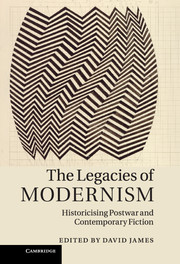Book contents
- Frontmatter
- Contents
- Notes on contributors
- Acknowledgements
- Introduction: mapping modernist continuities
- Part I Early legacies: inheriting modernism at mid century and beyond
- Part II Modernist aesthetics in transition: character, perception, innovation
- Chapter 4 Thinking in literature: modernism and contemporary neuroscience
- Chapter 5 Autonomous automata: opacity and the fugitive character in the modernist novel and after
- Chapter 6 Pseudo-impressionism?
- Chapter 7 ‘Advancing along the inherited path’: Milan Kundera, Philip Roth and the idea of being traditionally new
- Part III Reassessing the ethics of modernist fiction
- Part IV Modernism's global afterlives
- Epilogue Finding the dreadfully real
- Index
- References
Chapter 7 - ‘Advancing along the inherited path’: Milan Kundera, Philip Roth and the idea of being traditionally new
from Part II - Modernist aesthetics in transition: character, perception, innovation
Published online by Cambridge University Press: 05 November 2011
- Frontmatter
- Contents
- Notes on contributors
- Acknowledgements
- Introduction: mapping modernist continuities
- Part I Early legacies: inheriting modernism at mid century and beyond
- Part II Modernist aesthetics in transition: character, perception, innovation
- Chapter 4 Thinking in literature: modernism and contemporary neuroscience
- Chapter 5 Autonomous automata: opacity and the fugitive character in the modernist novel and after
- Chapter 6 Pseudo-impressionism?
- Chapter 7 ‘Advancing along the inherited path’: Milan Kundera, Philip Roth and the idea of being traditionally new
- Part III Reassessing the ethics of modernist fiction
- Part IV Modernism's global afterlives
- Epilogue Finding the dreadfully real
- Index
- References
Summary
I
Among modernism's many paradoxical attractions to what has passed, one stands out more than most. Though we could accurately call it a commitment, or hear it repeated as an obligation expressed by artists themselves, it might best be posed as a question: how can experimenters draw upon tradition without undermining their own claims to originality? Though this was a conundrum that high modernism undoubtedly intensified, it was hardly unprecedented. When George Eliot insisted that we notice how ‘each new invention casts a new light along the pathway of discovery, and each new combination or structure brings into play more conditions than its inventor foresaw’, she laid the groundwork for her poet namesake who, half a century later, famously advised his generation of aspiring writers that ‘existing monuments form an ideal order among themselves, which is modified by the introduction of the new (the really new) work of art among them’. T. S. Eliot may have been reluctant to admit that, as an ‘inventor’ himself, he might not always foresee where new ‘conditions’ arise for genuine innovation. Invariably, he was adamant that he could. And he took pains to identify himself with the rigour and insight of those who could acknowledge that tradition ‘cannot be inherited’, since ‘you must obtain it by great labour’, precisely in order to suggest how difficult it was for the modern poet to be new. Nonetheless, even if the two Eliots may not have agreed on the extent to which writers are capable of predicting what sort of ‘combination or structure’ newness will assume next, they would surely concur that the measure of ‘each new invention’ is the way it challenges all prior expectations – sending a ripple through assumptions of what's currently possible for the artistic medium in question. For, ‘after the supervention of novelty’, insists (T. S.) Eliot, ‘the whole existing order must be, if ever so slightly, altered’. So in turn ‘the relations, proportions, values of each work of art toward the whole are readjusted’, a mutual adjustment that reveals what Eliot pinpoints as ‘the conformity between the old and the new’.
- Type
- Chapter
- Information
- The Legacies of ModernismHistoricising Postwar and Contemporary Fiction, pp. 133 - 150Publisher: Cambridge University PressPrint publication year: 2011



